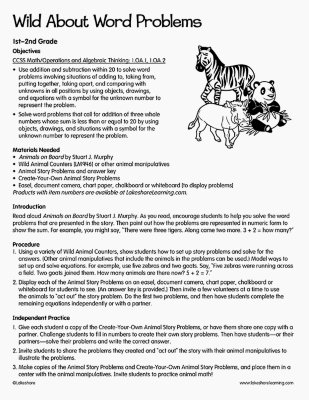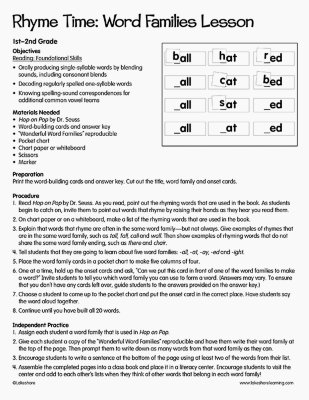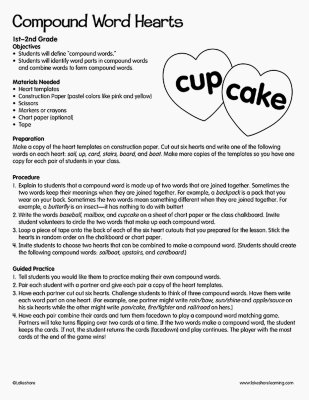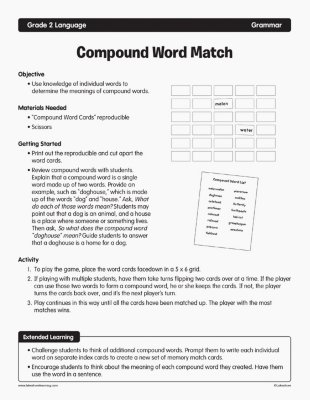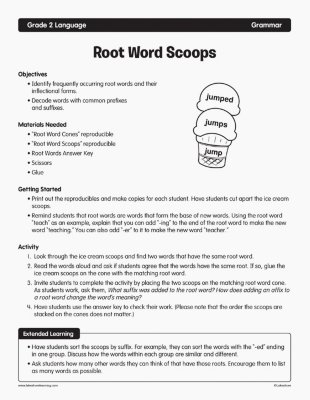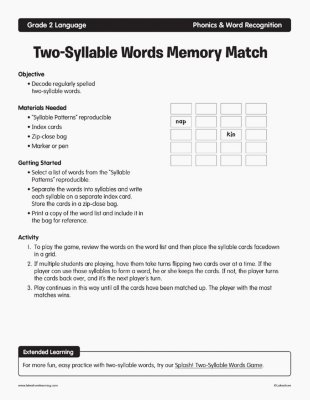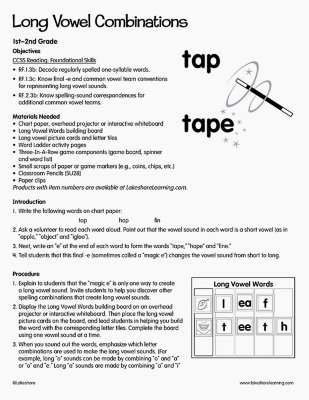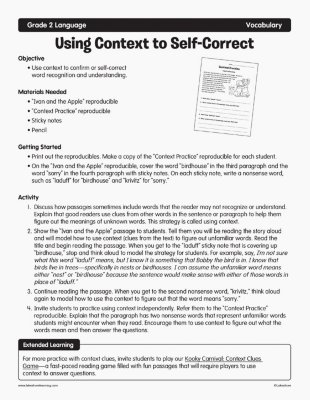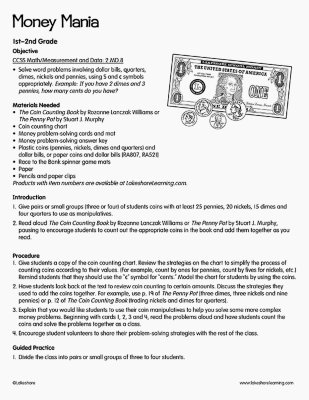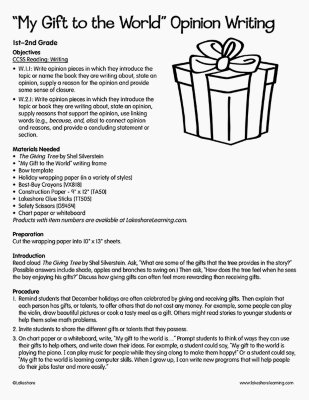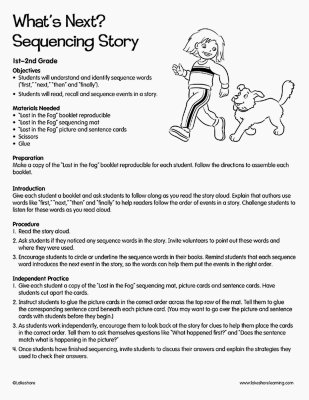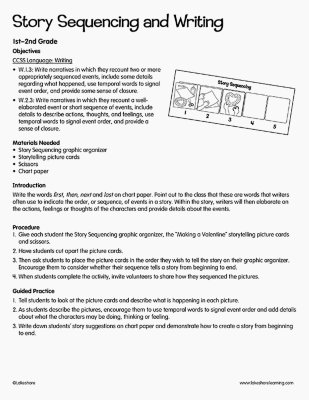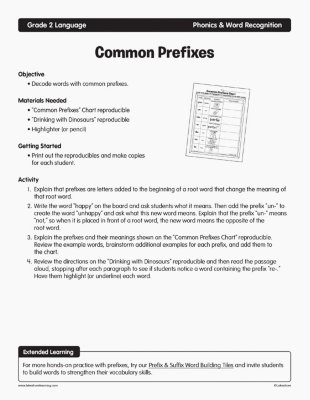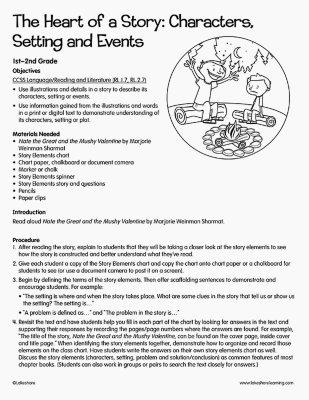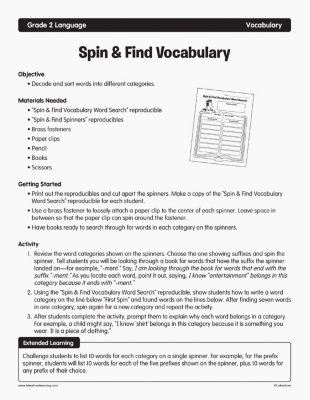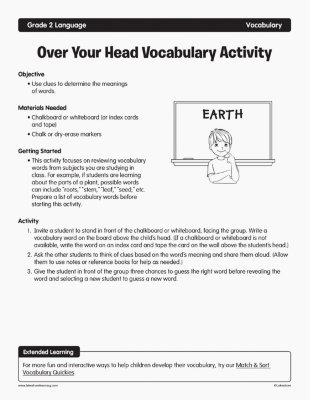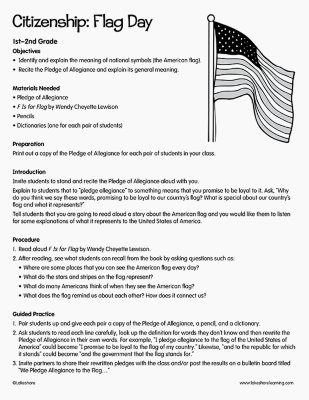Narrow by Grade
- Infant (1)
- Toddler (3)
- Preschool (0)
- Pre-K (14)
- Kindergarten (20)
- 1st (19)
- 2nd (18)
- 3rd (16)
- 4th (17)
- 5th (7)
- 6th & Up (0)
Grade 2nd
Narrow by Age
- 0-18m (0)
- 18-36m (0)
- 3 yrs. (0)
- 4 yrs. (0)
- 5 yrs. (0)
- 6 yrs. (9)
- 7 yrs. (18)
- 8 yrs. (0)
- 9 yrs. (0)
- 10 yrs. (0)
- 11 yrs. & Up (0)
Age
18 results for "word"
Filters
Clear All
Wild About Word Problems
1st Grade - 2nd Grade
Objectives CCSS Math/Operations and Algebraic Thinking: 1.OA.1, 1.OA.2 Use addition and subtraction within 20 to solve word problems involving situations of adding to, taking from, putting together, taking apart, and comparing with unknowns in all positions by using objects, drawings, and equations with a symbol for the unknown number to represent the problem. Solve word problems that call for addition of three whole numbers whose sum is less than or equal to 20 by using objects, drawings, and situations with a symbol for the unknown number to represent the problem. Materials Needed Animals on Board by Stuart J. Murphy Wild Animal Counters or other animal manipulatives Animal Story Problems and answer key Create-Your-Own Animal Story Problems Easel, document camera, chart paper, chalkboard or whiteboard [to display problems] Introduction Read aloud Animals on Board by Stuart J. Murphy. As you read, encourage students to help you solve the word problems that are presented in the story. Then point out how the problems are represented in numeric form to show the sum. For example, you might say, “There were three tigers. Along came two more. 3 + 2 = how many?”
View Lesson PlanRhyme Time: Word Families Lesson
1st Grade - 2nd Grade
Objectives Reading: Foundational Skills Orally producing single-syllable words by blending sounds, including consonant blends Decoding regularly spelled one-syllable words Knowing spelling-sound correspondences for additional common vowel teams Materials Needed Hop on Pop by Dr. Seuss Word-building cards and answer key “Wonderful Word Families” reproducible Pocket chart Chart paper or whiteboard Scissors Marker Preparation Print the word-building cards and answer key. Cut out the title, word family and onset cards.
View Lesson PlanCompound Word Hearts
1st Grade - 2nd Grade
Objectives Students will define “compound words.” Students will identify word parts in compound words and combine words to form compound words. Materials Needed Heart templates Construction Paper - 9" x 12" (pastel colors like pink and yellow) Scissors Markers or crayons Chart paper (optional) Tape Preparation Make a copy of the heart templates on construction paper. Cut out six hearts and write one of the following words on each heart: sail, up, card, stairs, board, and boat. Make more copies of the templates so you have one copy for each pair of students in your class.
View Lesson PlanCompound Word Match
2nd Grade
Objective
- Use knowledge of individual words to determine the meanings of compound words.
Root Word Scoops
2nd Grade
Objectives
- Identify frequently occurring root words and their inflectional forms.
- Decode words with common prefixes and suffixes.
Two-Syllable Words Memory Match
2nd Grade
Objective
- Decode regularly spelled two-syllable words.
Long Vowel Combinations
1st Grade - 2nd Grade
Objectives CCSS Reading: Foundational Skills RF.1.3b: Decode regularly spelled one-syllable words. RF.1.3c: Know final -e and common vowel team conventions for representing long vowel sounds. RF.2.3b: Know spelling-sound correspondences for additional common vowel teams. Materials Needed Chart paper, overhead projector or interactive whiteboard Long Vowel Words building board Long vowel picture cards and letter tiles Word Ladder activity pages Three-In-A-Row game components (game board, spinner and word list) Small scraps of paper or game markers (e.g., coins, chips, etc.) Classroom Pencils Paper clips Introduction Write the following words on chart paper: tap hop fin Ask a volunteer to read each word aloud. Point out that the vowel sound in each word is a short vowel (as in “apple,” “object” and “igloo”). Next, write an “e” at the end of each word to form the words “tape,” “hope” and “fine.” Tell students that this final -e (sometimes called a “magic e”) changes the vowel sound from short to long.
View Lesson PlanMystery Coins
1st Grade - 2nd Grade
Objectives Number & Operations in Base Ten Understanding 10 as a bundle of ten ones Skip-counting by 5s, 10s, and 100s Measurement & Data Solving word problems involving dollar bills, quarters, dimes, nickels, and pennies, using $ and ¢ symbols Materials Needed Plastic coins (or paper coins reproducible and scissors) Coin Values reproducible Mystery Coins reproducible Chart paper Marker Introduction Hold up each coin and review its name and value. You may want to print out and display the Coin Values reproducible for students to use as a reference. Be sure to show students both sides of each coin, and remind them that larger coins do not necessarily have greater values.
View Lesson PlanUsing Context to Self-Correct
2nd Grade
Objective
- Use context to confirm or self-correct word recognition and understanding.
Money Mania
2nd Grade
Objective CCSS Math/Measurement and Data: 2.MD.8 Solve word problems involving dollar bills, quarters, dimes, nickels and pennies, using $ and ¢ symbols appropriately. Example: If you have 2 dimes and 3 pennies, how many cents do you have? Materials Needed The Coin Counting Book by Rozanne Lanczak Williams or The Penny Pot by Stuart J. Murphy Coin counting chart Money problem-solving cards and mat Money problem-solving answer key Plastic coins (pennies, nickels, dimes and quarters) and dollar bills, or paper coins and dollar bills Race to the Bank spinner game mats Paper Pencils and paper clips Introduction Give pairs or small groups (three or four) of students coins with at least 25 pennies, 20 nickels, 15 dimes and four quarters to use as manipulatives. Read aloud The Coin Counting Book by Rozanne Lanczak Williams or The Penny Pot by Stuart J. Murphy, pausing to encourage students to count out the appropriate coins in the book and add them together as you read.
View Lesson PlanMy Gift to the World Opinion Writing
1st Grade - 2nd Grade
Objectives CCSS Reading: Writing W.1.1: Write opinion pieces in which they introduce the topic or name the book they are writing about, state an opinion, supply a reason for the opinion and provide some sense of closure. W.2.1: Write opinion pieces in which they introduce the topic or book they are writing about, state an opinion, supply reasons that support the opinion, use linking words (e.g., because, and, also) to connect opinion and reasons, and provide a concluding statement or section. Materials Needed The Giving Tree by Shel Silverstein “My Gift to the World” writing frame Bow template Holiday wrapping paper (in a variety of styles) Best-Buy Crayons Construction Paper - 9" x 12" Lakeshore Glue Sticks Safety Scissors Chart paper or whiteboard Preparation: Cut the wrapping paper into 10" x 13" sheets. Introduction Read The Giving Tree by Shel Silverstein. Ask, “What are some of the gifts that the tree provides in the story?” (Possible answers include shade, apples and branches to swing on.) Then ask, “How does the tree feel when he sees the boy enjoying his gifts?” Discuss how giving gifts can often feel more rewarding than receiving gifts.
View Lesson PlanWhat’s Next? Sequencing Story
1st Grade - 2nd Grade
Objectives Reading Literature Retelling stories and demonstrating understanding of the central message or lesson Describing characters, settings, and major events in a story, using key details Understanding and identifying sequence words (e.g., “first,” “next,” “then,” “finally”) Materials Needed Lost in the Fog booklet reproducible Lost in the Fog sequencing mat Lost in the Fog picture and sentence cards Best-Buy Scissors Lakeshore Glue Sticks Pencils Preparation Make a copy of the Lost in the Fog booklet reproducible, sequencing mat, picture cards and sentence cards for each student. Follow the directions to assemble each booklet. Introduction Give each student a booklet and ask students to follow along as you read the story aloud. Explain that authors use words like “first,” “next,” “then” and “finally” to help readers follow the order of events in a story. Challenge students to listen for these words as you read aloud.
View Lesson PlanStory Sequencing and Writing
1st Grade - 2nd Grade
Objectives CCSS Language: Writing W.1.3: Write narratives in which they recount two or more appropriately sequenced events, include some details regarding what happened, use temporal words to signal event order, and provide some sense of closure. W.2.3: Write narratives in which they recount a well-elaborated event or short sequence of events, include details to describe actions, thoughts, and feelings, use temporal words to signal event order, and provide a sense of closure. Materials Needed Story Sequencing graphic organizer Storytelling picture cards Scissors Chart paper Introduction Write the words first, then, next and last on chart paper. Point out to the class that these are words that writers often use to indicate the order, or sequence, of events in a story. Within the story, writers will then elaborate on the actions, feelings or thoughts of the characters and provide details about the events.
View Lesson PlanThe Heart of a Story: Characters, Setting and Events
1st Grade - 2nd Grade
Objectives Using illustrations and details in a story to describe its characters, setting or events Using information from illustrations and words to demonstrate understanding of characters, setting or plot Materials Needed Nate the Great and the Mushy Valentine by Marjorie Weinman Sharmat Story Elements chart Chart paper, chalkboard or document camera Marker or chalk Story Elements spinner Story Elements story and questions Pencils Paper clips Introduction Read aloud Nate the Great and the Mushy Valentine by Marjorie Weinman Sharmat.
View Lesson PlanSpin & Find Vocabulary
2nd Grade
Objective
- Decode and sort words into different categories.
Over Your Head Vocabulary Activity
2nd Grade
Objective
- Use clues to determine the meanings of words.
Citizenship: Flag Day
2nd Grade
Objectives Identify and explain the meaning of national symbols (the American flag). Recite the Pledge of Allegiance and explain its general meaning. Materials Needed Pledge of Allegiance F Is for Flag by Wendy Cheyette Lewison Pencils Dictionaries (one for each pair of students) Introduction Invite students to stand and recite the Pledge of Allegiance aloud with you. Explain to students that to “pledge allegiance” to something means that you promise to be loyal to it. Ask, “Why do you think we say these words, promising to be loyal to our country’s flag? What is special about our country’s flag and what it represents?” Tell students that you are going to read aloud a story about the American flag and you would like them to listen for some explanations of what it represents to the United States of America.
View Lesson Plan